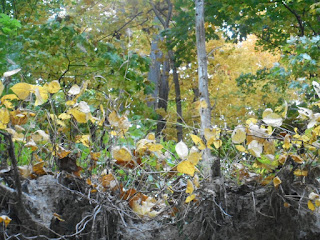Entering Autumn
October 24, 2015
Autumn was in full “bloom” by October 24, bursting with fiery
colors. Some green still dotted the wood-scape.
We had been through a long, dry period. I went to Cottonwood
Pond twice on October 24, the second time after a light rain. It was not enough
to make up for a drought, and was absorbed quickly.
The Creek bed was barely distinguishable.
The mass of Jewelweed plants between the Creek and Cottonwood
Pond were obviously spent, but still a faded green.
As would be expected, the main “pond” was dry, save for some
dampness in the mud.
This time, though, the bottom was almost covered with fallen
leaves. Of course, there was nothing to flow through the Seep.
Start of Seep, at corner of Pond
Bark Ledge at end of Seep, at Creek
After the rain, leaves on the bottom glistened with moisture.
In 2013 at this time, there was some water in the main pond.
As leaves fell, they collected gently on top until they covered the water
surface. More leaves piled on top of those. The extra weight caused the bottom
layer to be submerged. As they became submerged,, they absorbed water, darkened
and sank to the muddy bottom. After awhile, there was a layer of almost black
leaf detritus on the bottom, seen through the water. Eventually, organisms
broke down the detritus, and also lived in it, until it became part of the
bottom soil.
In 2014, leaves were absorbed into a muddy bottom (see
“Cottonwood Mud Hole" – November 13, 2014.)
This time, dry, colorful leaves accumulated directly on the
bottom, with very little moisture. Any precipitation settled on top and was
likely to evaporate if the wetness was not significant. If we had no more rain
for a long time, or very little, the breakdown of leaves on the dry bottom of
Cottonwood “Pond” would be the same as that on the forest floor, with
significant water introduced at some later time. How would this affect the
cycle of life?
The canopy, from whence come the leaves on Cottonwood Pond …
Jewelweed plant growing in a damp, protected spot on Mud Pile #2
The Cove
I looked at the top edge of the Root Ball. Yellowed Poison
Ivy leaves decorated it like a laurel leaf crown.
The Maple Sapling, still green(which was decorated by a
Northern Water Snake in May of 2014):
Green Maple sapling in lower left
As seen from the top side of the Root Ball
The claw-like rootlet hanging from the Root Ball bottom was
still holding onto its ball of mud, which hadn't disintegrated much ...
... but when I made my second visit that day it was on the
ground, broken off.
It looked like it would hang on to its ball of mud no matter
what.
The Inlet was, of course, very clear.
Looking across the main Pond to the Inlet
As seen from the southeast
Looking down on the Barkless Log, the main pond on the right
The normally soggy area just before the Inlet, where water pours in to the pond
On the other side of the Root Ball, Wood Nettle plants hung
limp and dry with remnants of green color …
… while vibrant, green Wood Nettles still lived along the
damp base, near the Trunk.
Looking across "little pond"
In fact, the top part of the Root Ball was damp and dark,
compared to the relatively bare, dry Root Ball bottom, and tiny gnats swarmed
around there.
Some thin vines trailed down:
Below the Trunk, I spotted a tiny Chorus Frog! The light rain
must have brought it out of hiding.
Something had been digging a hole under the Trunk.
There was something that I decided merited attention. On top
of the Trunk, near its base, there was a Blue Beech sapling which has been
growing rapidly. The interesting thing is that it was three-pronged at its
base; one branch extended horizontally along the trunk while two branches
extended vertically from that same point. There was another vertical branch a
little further along the horizontal one.
This will be interesting to watch, and as it matures it will
have some affect on Cottonwood Pond.
These are its leaves overhead:
I decided to follow the Trunk up the slope ...
… to where the top was lodged in the crook of a two-trunk Red
Oak at the top of the slope.
The top of the Cottonwood separates into two limbs. Here is
the tip of the upper limb …
… and the tips of branches (extending from the top right in
the photo) at the end of the lower limb.
From the giant root base to tiny branch tips, this grand,
fallen tree has provided new life for other organisms and a story for me to
follow and tell.
*******************************************************************************
This year, so far, our weather and Cottonwood Pond have gone
from one extreme to another. Early in the year, rain was almost relentless,
over-filling the pond and Creek. The whole area was like a swamp. Later, after
a drought, the “pond” completely dried up. I went from watching water-loving
creatures from the far edge of the water (wearing boots) to simply standing in
the middle with dry shoes.
Gary Trudeau, author of the comic strip “Doonesbury” created
a character in the early days of the strip called Zonker Harris. I've always
loved Zonker's child-like zest for life, and so I could relate to his disappointment
when this happened at his beloved “Walden Puddle”:





































































































